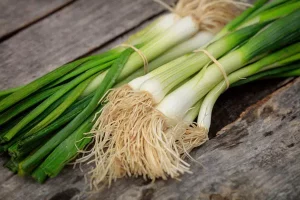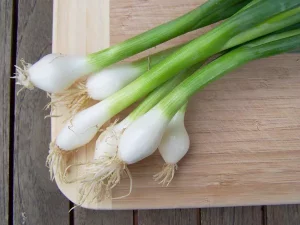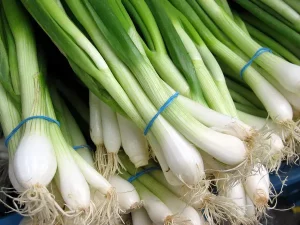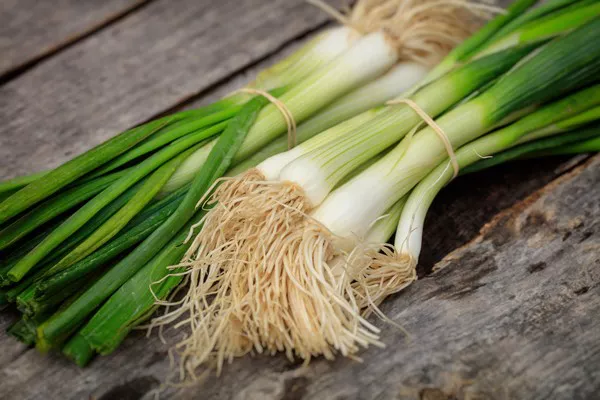In the realm of culinary delights, a trio of onion-like vegetables often perplexes even the seasoned chefs: scallions, green onions, and spring onions. While these terms are often used interchangeably, each of these vegetables possesses its own unique attributes and characteristics that set them apart. In this comprehensive exploration, we delve into the world of scallions, green onions, and spring onions, shedding light on their origins, appearances, flavors, and culinary applications.
Scallions, Green Onions, and Spring Onions
1. Scallions
Scallions, scientifically known as Allium fistulosum, are commonly referred to as “true” scallions. These vegetables are distinguished by their long, straight green stalks and small white bulbs. In many culinary traditions, scallions are preferred for their mild onion flavor and are often used raw or lightly cooked to enhance dishes without overpowering them.
2. Green Onions
Green onions, often considered synonymous with scallions, share many similarities with their culinary counterpart. Yet, the term “green onions” is also used to describe young onions that have been harvested before the bulb has fully formed. These immature onions boast a milder taste and are characterized by their slender green stalks and underdeveloped white bulbs.
3. Spring Onions
Spring onions, known scientifically as Allium cepa var. fistulosum, are a bit more distinct. These onions are harvested at a slightly later stage than green onions, offering a more developed and rounded white bulb. While their green tops remain vibrant and flavorful, the overall taste of spring onions tends to be stronger than that of green onions or scallions.
See Also: Scallions: Varieties, Uses, Benefits & Growing Methods
Analyzing the Appearance: Scallions, Green Onions, and Spring Onions
1. Scallions
True scallions exhibit long, straight green shoots that culminate in small, white bulbs. Their appearance is marked by the absence of a significant bulb formation.
2. Green Onions
Green onions possess a visual resemblance to true scallions, with slender, elongated green stalks and smaller, less pronounced white bulbs.
3. Spring Onions
Spring onions are the most visually distinct of the trio. They feature elongated green tops and more substantial white bulbs that resemble miniature versions of traditional bulb onions.
Decoding the Flavors: Scallions, Green Onions, and Spring Onions
The flavor differences between scallions, green onions, and spring onions are relatively subtle due to their close botanical relationships. However, the differences do exist and can affect the overall taste of dishes. Keep in mind that these differences can vary based on factors such as growing conditions and individual taste perceptions. Here’s a general breakdown of the flavor distinctions:
1. Scallions
Scallions typically have a mild and slightly pungent flavor. The white bulbs of scallions are milder in taste compared to mature onions, and they provide a gentle onion essence to dishes. The green tops of scallions have a fresher, grassy flavor with hints of mild onion. The overall flavor profile is delicate and doesn’t overpower other ingredients, making scallions a popular choice for garnishing and adding subtle onion notes to dishes.

2. Green Onions
Green onions share a flavor profile similar to scallions, which is mild and slightly pungent. The term “green onions” is often used interchangeably with scallions, referring to the young plants with green stems and small, underdeveloped white bulbs. As such, the flavor of green onions closely mirrors that of scallions—mild, slightly onion-like, and not as intense as mature onions.

3. Spring Onions
Spring onions have a slightly stronger flavor compared to scallions and green onions. The white bulb of a spring onion has a more developed onion taste, similar to that of mature onions but still milder. The green tops of spring onions offer a slightly sharper onion flavor compared to the delicate grassiness of scallion greens. The overall taste of spring onions strikes a balance between mild and moderate onion flavors, making them a versatile option in dishes where you want a bit more onion presence.

Cooking Considerations:
When cooking with these types of onions, consider the level of onion flavor you want to achieve in your dish:
- If you’re looking for a subtle, fresh onion taste that won’t dominate the dish, opt for scallions or green onions.
- If you want a slightly stronger onion flavor but still prefer something milder than fully grown onions, spring onions would be a good choice.
- For dishes where a bolder onion flavor is desired, you might opt for fully grown onions.
Embracing Culinary Uses: Scallions, Green Onions, and Spring Onions
The culinary uses of scallions, green onions, and spring onions are quite similar due to their closely related nature and mild onion flavor. While these terms are often used interchangeably, there can be slight differences in how they are used based on regional and cultural preferences. Here’s a breakdown of their common culinary uses:
1. Scallions:
Scallions are commonly used in various cuisines to add a mild onion flavor and a touch of freshness. They are versatile and can be used both raw and cooked. Some common culinary uses of scallions include:
Garnish: Chopped scallions are frequently used as a garnish for dishes like soups, salads, rice bowls, and tacos. The green tops provide a burst of color and a mild onion flavor.
Stir-fries: Scallions are often included in stir-fry dishes, contributing a subtle onion taste and crunch.
Sauces and Dips: Chopped scallions can enhance the flavor of sauces, dips, and dressings, such as in guacamole, salsa, or sour cream-based dips.
Omelets and Eggs: Scallions can be added to omelets, scrambled eggs, and quiches to provide a mild onion note without overwhelming the dish.
Noodle Dishes: They are commonly used in Asian noodle dishes like ramen, udon, and stir-fried noodles.
2. Green Onions:
Green onions, often used interchangeably with scallions, have similar culinary uses:
Garnish: Like scallions, green onions are used as a garnish for a wide range of dishes to add color and a subtle onion flavor.
Salads: Sliced green onions can be tossed into salads to contribute a mild onion taste.
Sautéed and Grilled: Green onions can be sautéed or grilled as a side dish or topping for grilled meats.
Marinades: Chopped green onions can be included in marinades to infuse a delicate onion essence into the meat.
Asian Cuisine: Green onions are frequently used in Asian cuisines, such as Chinese, Japanese, and Korean dishes.
3. Spring Onions:
Spring onions, with their slightly stronger flavor compared to scallions and green onions, can be used in similar ways:
Cooked Dishes: Spring onions are often used in cooked dishes like frittatas, savory pancakes, and quiches to provide a more pronounced onion flavor.
Roasting: Roasted spring onions can be served as a side dish or incorporated into roasted vegetable medleys.
Grilling: Grilled spring onions can be served alongside grilled meats or used as a topping for burgers.
Mashed Potatoes: Spring onions can be added to mashed potatoes for an extra layer of flavor.
Why the Confusion?
There is often confusion about whether or not green onions and spring onions are the same thing, and this might stem from the fact that green onions are called spring onions in other countries, such as Canada and the United Kingdom.
Can You Substitute One for the Other?
The flavors and textures of scallions and spring onions are similar, but keep in mind that they have a different intensity of flavors. I don’t recommend using spring onions in place of scallions if the scallions are left raw, as spring onions have a stronger flavor.
If you’re planning on cooking the scallions or spring onions, however, then the cooking will mellow and even out the differences, so they’re fairly interchangeable for this use.
How can I reduce the strong onion flavor in my dish?
If you find the onion flavor in your dish to be too strong, there are several methods you can use to mellow or reduce the intensity of the flavor. Here are some techniques to help you achieve a more balanced taste:
1. Blanching:
Blanching involves briefly boiling the chopped onions and then immediately placing them in ice water to stop the cooking process. This can help soften the onion flavor and make it milder. Here’s how to do it:
Bring a pot of water to a boil.
Add the chopped onions and blanch them for about 30 seconds to 1 minute.
Quickly transfer the onions to a bowl of ice water to cool down.
Drain the onions and use them in your dish.
2. Soaking:
Soaking chopped onions in cold water for a period of time can also help reduce their strong flavor. This method works well when you’re using onions in salads or raw dishes. Follow these steps:
Place the chopped onions in a bowl of cold water.
Let them soak for about 10 to 15 minutes.
Drain the onions and pat them dry before using.
3. Marinating:
If your recipe allows for it, marinating the chopped onions in a mild acidic liquid like lemon juice, vinegar, or even milk can help mellow the flavor. The acid in the marinade can help break down some of the compounds responsible for the strong taste.
4. Sautéing:
Cooking the onions slowly over low heat can help mellow their flavor as well. When you sauté onions, their natural sugars caramelize and their pungency decreases.
5. Mixing with Other Ingredients:
Mixing the strong-flavored onions with other ingredients that have more pronounced flavors can help balance out the overall taste of the dish. For example, using them in combination with creamy sauces, cheese, or other vegetables can help mask the strong onion flavor.
6. Using Milder Onion Varieties:
If you’re looking to avoid a strong onion flavor altogether, consider using milder onion varieties like sweet onions or shallots in your dishes.
7. Gradual Cooking:
If your dish involves cooking the onions, adding them early in the cooking process and allowing them to cook gradually can help reduce their sharpness as they break down and meld with other flavors.
8. Reduce Quantity:
Simply using a smaller quantity of onions than the recipe calls for can help reduce their flavor impact.
Conclusion
In the intricate tapestry of culinary vocabulary, the terms scallions, green onions, and spring onions interweave, causing confusion and curiosity alike. By dissecting their nomenclature, appearances, flavors, and applications, we’ve unveiled the nuances that distinguish these onion-like vegetables. Whether you opt for the gentle elegance of scallions, the youthful appeal of green onions, or the more robust presence of spring onions, understanding their unique attributes empowers culinary enthusiasts to wield these ingredients with finesse, elevating dishes from the mundane to the exceptional.

